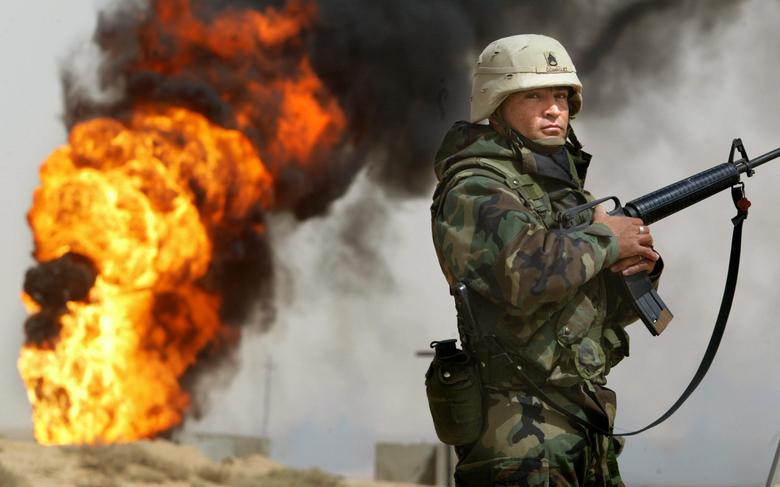
IRAQ OIL ALERT

Increasing violence in Iraq, Opec's second-largest oil producer, has spooked many markets, including oil.
It has also elicited loud punditry about an emerging oil crisis, a need for the US to release strategic petroleum reserves and significantly higher prices throwing a monkey wrench into plans for global economic growth. But what are markets actually saying?
So far, the oil market's reaction has been fairly benign. At most, there is a $5 premium in spot prices and perhaps a risk premium half that size in forward prices. Spot prices of Brent crude oil jumped 4.5 per cent (about $5 per barrel) on the fall of Mosul and the spreading territorial control of the Islamic State of Iraq and the Levant (known as Isis) over central Iraq.
Deferred (five-year) prices also jumped, albeit by a more modest 3 per cent ($3, to about $98) on the heels of consumer hedging. Prices barely budged after military conflict emerged around the Baiji refinery that provides diesel and gasoline for Baghdad.
Exports uninterrupted
There has been no impact on Iraqi exports so far. The only disruption took place in March, the last time the pipeline delivering crude from the Kirkuk field in the north to Ceyhan in Turkey, was blown up.
Exports from the south are slated to reach 2.8m b/d next month, a 30-year high, and could grow further now that new export infrastructure is in place. Exports from the northern Kurdistan Regional Government (KRG) area are currently about 120,000 b/d and also remain well out of harm's way. Pending an agreement on revenue-sharing, which looks more likely given Baghdad's need for cash, production could grow by another 100,000 b/d for the KRG by year-end.
Controlling the border is also another step towards the group's aim of creating a caliphate run on a fundamentalist reading of Islamic law.
At stake is the 650,000 b/d of other northern production, in the so-called Sunni triangle including Kirkuk, and that is already down to about 400,000 b/d given the closing of Kirkuk production, now under KRG control. But no additional export flows are threatened.
Perhaps misleadingly, the International Energy Agency has indicated that its estimated call on Opec for 2014 will be 30.1m b/d, versus recent Opec production of about 30m b/d, indicating that markets might already be tight. But the agency is positing US oil production growth this year of 850,000 b/d versus year-to-date growth of 1.35m b/d.
The IEA also projects US natural gas liquids production rising by 276,000 b/d this year, but already in the first quarter it rose by 178,000 b/d. Add up surprising growth in other places, including Colombia and Argentina, and the world looks better supplied this year than the IEA indicates.
That does not make the events unfolding in Iraq significantly less worrying for oil markets. Pre-Libyan crisis the level of oil flows disrupted by civil unrest or international conflict was normally about 500,000 b/d. Post-Libya, oil flows offline have increased, first to a level of about 2m b/d and more recently to a level above 3.5m b/d, including sanctions on Iran.
Kirkuk field vital
Surprisingly, oil prices have not changed much and indeed Brent, the global benchmark, has averaged close to $110 every quarter since the Libyan crisis, as lost supplies have been made up by Saudi Arabia using spare production capacity and the US increasing its production by about 1m b/d annually.
But with the possibility of political fragmentation in Iraq, and with civil unrest emerging in other petro-states, there are valid concerns about reliance on supply from Opec in future.
Other potential consequences must also be considered. Iraq is still sticking to a production target of more than 8m b/d by 2020, which would involve southern production ramping up to 6.75m b/d.
However, for many, the bigger issue is not what happens today or tomorrow but what the lightening advance of Isis means for the country's oil industry in the longer term.
But even under the best case scenario, Iraqi export capacity in the Gulf looks likely to be capped at 4m b/d. If use of the strategic north-south pipeline is effectively lost through permanent political fragmentation, global balances would suffer. Use of pipelines through Turkey would be required to export production above the 4m b/d level.
On the other hand, the outlook for production growth in the KRG region has improved considerably. Ironically, this could result in Iraqi production actually increasing significantly this year if an agreement is reached on revenue collection and sharing between Baghdad and Erbil.
With the KRG's militia having taken the Kirkuk field, the possibility now exists for interrupted Kirkuk flows to be brought to market through the KRG's pipeline to and through Turkey. With pipeline capacity of 400,000 b/d, those flows could increase by as much as 280,000 b/d by year-end. Longer-term, the KRG region could attract more capital for further development of its oil resources as well.
Meanwhile, the price premium is justified: global markets do not have much more wiggle room for another supply disruption.
ft.com



